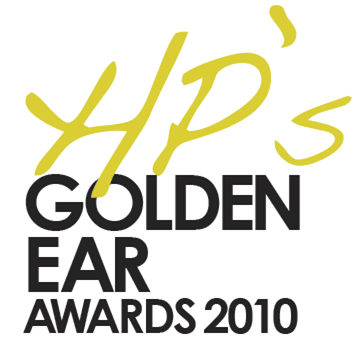
Sanders Model 10c Hybrid Electrostatic Speaker System
(click here to see PDF of award)
Roger Sanders' new speaker system strikes me as being a remarkable achievement, with much of the potential of a thought-through electrostatic design and few of its inherent disadvantages. True, it is a hybrid system, with a 10-inch transmission-line woofer on each side, slyly mated (at a low frequency, 172 Hertz) to the 'stat panels. But those woofers, driven by Sanders' own 350-watt solid-state amp, are capable of pressurizing a room in ways that almost no full-range electro stat working solo can, and, more to the point, these 'stat panels can be played at virtually any level you choose (at least short of incurring hearing loss), even with Bryston's 1000-watt mono blocks. Moreover, the transition between the woofers and the 'stats is surprisingly seamless, so that this system sounds more like a coherent whole than such matings almost always do.
Of course, you have to sit in the sweet spot-the apex of an equilateral triangle opposite the two canted-in speakers-in order to fully realize its potential (its headphone-like nature drove my assistant, Joey Weiss, to call it "a selfish speaker"). But Sanders argues that such a narrowly defined "center" listening spot is essential if the proper phase relationships of a musical signal are to be correctly rendered. That is, if the imaging is to be both fixed and focused. And he will (in an upcoming interview) go into some detail on placement and room problems. For example, he is opposed to passive bass absorbers because of the way they mar correct phase reproduction.
Sanders also adamantly opposes the use of tubed or tube-based amplifiers with this system. An electrostatic speaker acts essentially as a capacitor, and as the frequencies go up, an amp's output impedance must go down, or the top octaves will be lost. Which leaves you with the "warm" midrange so prized by hi-fi addicts. HP (that's me) used to believe that tubes would sound best with 'stats, but found out the hard way that this simply is not the case, and this before reading Sanders' tech papers on the topic.
More specifically, using a wonderful Linn recording of Bach's Goldberg Variations [Matthew Halls, Linn CKD 356] on the reference Scaenas, I found the harpsichord reproduction for the first time particularly true to the sound of the instrument itself. I supposed, at first, that with the ultra-resolution of the Sanders, this sound might just be, if anything, more delicately natural. But when the Sanders were mated with a tubed unit we had in house (which shall go unnamed not because it isn't good, but because of the mismatch), the harpsichord didn't sound "authentic" at all, but colored, most hi-fi-like. In other words, Technicolored in the mids and missing the airy overtones in the highs that distinguished dUs particular instrument. So it was out with the tubes and in with the transistors. First, a unit of Sanders own design, and, then for the ultimate in power (which the 10s can take), we inserted the stunningly uncolored (read: no transistor signature) update to the Bryston 28Bs. It has an output impedance of 0.02 ohms, rising slightly (to 0.03 ohms) at 20kHz. And the sound, from the harpsichord to full orchestra, went from transparent to the verge of translucency.
The top octave of the Brystons, as mentioned elsewhere, is particularly open and this lets you hear into the sound field in an almost unique way, thanks to a much larger power supply and more sophisticated capacitors. And on the big stuff, especially the minimally miked big stuff, the exact positioning of instruments, in a field of remarkable depth, was unimpeachable. And one more thing that became apparent, especially to a veteran listener who dropped by for a session, was the speakers' ability to recreate a sense of the vertical height of a soundstage.
Some may find the highly revealing sonics disturbing, especially if they've been bred and buttered, over the years, on "hi-fi" colorations. And I shall have much more to say on the topic. And on this speaker system. Price: $13,000. (This includes a digital crossover and the separate amp that drives the bass units, as well as Sanders-designed cables to match the 'stats to the amp of your choice. There is also a Model lOB, with an analog crossover, which itself includes the amp to drive the bass. Same price.)
Designer: Roger Sanders.
Contact: sanderssoundsystems.com
To see the award, please see The Absolute Sound Issue #203 at this link
http://www.avguide.com/magarchive/theabsolutesound/2010
